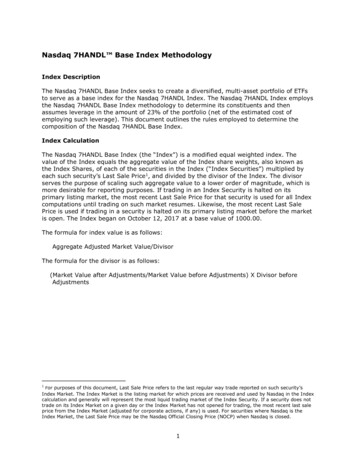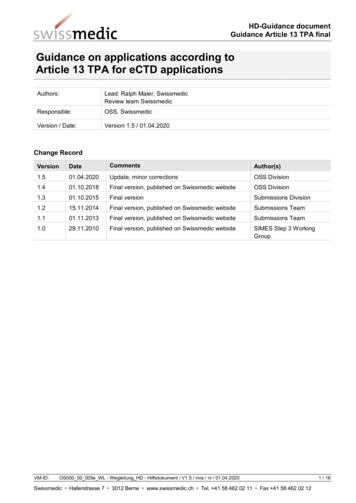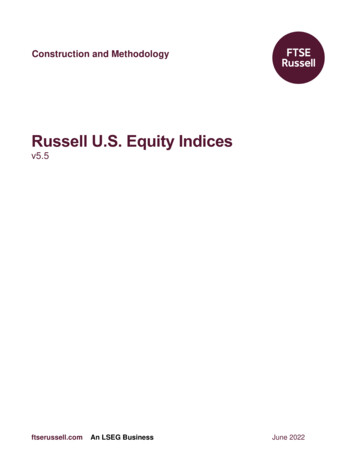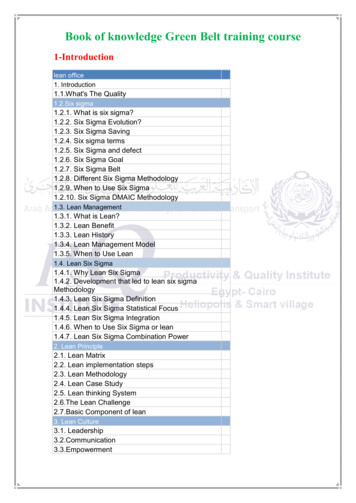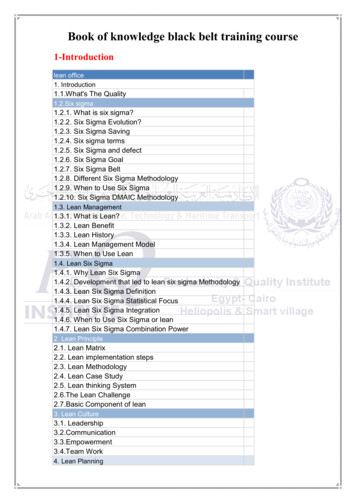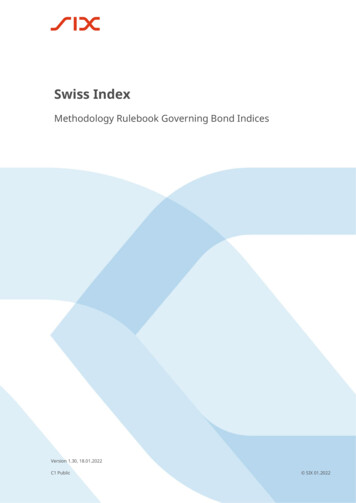
Transcription
Swiss IndexMethodology Rulebook Governing Bond IndicesVersion 1.30, 18.01.2022C1 Public SIX 01.2022
Swiss IndexMethodology Rulebook Governing Bond IndicesVersion 1.30, 18.01.2022Table of Contents1Introduction .42General Principles .43Revision History .44Definitions .54.14.2Instrument Definitions.5Bond Index Definitions .65Calculation of Index Values.75.1Laspeyres Formula .75.1.15.1.25.1.35.1.45.2Theoretical Adjustments of Corporate Actions .7Price Return Index .7Gross Return Index .8Practical Application of Corporate Actions .8Specific Fixed Income Indices .95.2.15.2.2Yield Index .9Duration Index (Macaulay Duration). 106Maintenance of Components.116.16.2Review of Filter Attributes . 11Priority of Prices Used in Reference Values . 117Maintenance of Index Composition .127.17.2Index Dependencies . 12Ordinary Index Review. 128SBI Index .138.18.2Overview . 13Index Composition . 139Derived Indices from SBI Using Filters .149.19.2Overview . 14Classification . 149.2.19.2.2Segment Scheme . 14Guarantee and Collateral Scheme . 149.39.49.59.69.7Nominal Amount . 14Domicile . 14Residual Term . 15SBI Composite Rating . 15ESG Eligibility . 1510Correction Policy.1610.1 Unavailable Data. 1610.2 Wrong Data . 16C1 PublicPage 2
Swiss IndexMethodology Rulebook Governing Bond IndicesVersion 1.30, 18.01.202211Governance .1612External Communication.1913Trademark Protection, Use of Licensing .2014Contact .20Appendix A SBI Composite RatingA.1A.221Sources for the SBI Composite Rating . 21Determination of the SBI Composite Rating . 21Appendix BSegment Classification Scheme23Appendix CGuarantee and Collateral Scheme24C.1C.2C.3Determination of the Level 1 Code . 24Determination of the Level 2 Code . 25Determination of the Level 3 Code . 26Appendix D ICB Fixed Income Table27Appendix EESG Eligibility and Attributes28Appendix FOverview of the Offering30F.1F.2F.3Indices Calculated Under the Segment Classification Scheme. 30Indices Calculated Under the Guarantee and Collateral Scheme . 31Indices Calculated with ESG Eligibility Criteria . 32C1 PublicPage 3
Swiss IndexMethodology Rulebook Governing Bond Indices1Version 1.30, 18.01.2022IntroductionThis document is an integral part of the Swiss Index Rules. The Swiss Index Rules are outlined in a MethodologyRulebook for Equity and Real Estate Indices, Bond Indices, Strategy Indices and Swiss Reference Rates. This is theMethodology Rulebook governing Bond Indices. The initial section ‘General principles’ outlines the guiding principlesunderlying the rulebook and the application of the rules. The next section provides an overview of the definitionsused in this rulebook. It is followed by a section on the calculation of indices and the outlines on the maintenance ofindex components, composition. The document closes with sections on correction policy, governance, externalcommunication and trademark protection.2General PrinciplesThis rulebook is based on the general principles stated below. SIX uses the principles as an orientation and guidingprinciples for unforeseen circumstances that are not covered by the rulebook or in case of doubt.3–Representative: The development of the market is represented by the index.–Tradable: The index components are tradable in terms of issuer size and market.–Replicable: The development of the index can be replicated in practice with a portfolio.–Stable: High index continuity.–Rule-based: Index changes and calculations are rule-based.–Projectable: Changes in rules are applied with appropriate notification period (usually at least 2 trading days) –no retrospective rule changes.–Transparent: Decisions are based on public information.Revision HistoryDateVersionDescription04.10.20211.00Changed assignment of bonds into maturity buckets (from “yield to worstterm” to “residual term”),Updated eligibility criteria for bonds by introducing “Seniority” in chapter 8.2;Clarified use of Fedafin corporate ratings as well as handling of restrictedratings in section A.2.15.11.20211.10Introduced a definition for bonds which are listed on both, SIX Swiss Exchangeand SIX Digital Exchange (“SDX listed bonds") and an explanation of thecalculation of the nominal amount for these bonds29.12.20211.20Expanded and re-worded Section 10 Governance, mainly to increasetransparency of bodies and concepts when calculating indices18.01.20221.30Included SBI Domestic Government 1m – 3yearsC1 PublicPage 4
Swiss IndexMethodology Rulebook Governing Bond Indices4Definitions4.1Instrument DefinitionsVersion 1.30, 18.01.2022SIX offers indices which replicate the development of a weighted group of instruments. Since the underlyinginstruments of the indices described in this rulebook are bonds, their attributes are defined underneath:TermDefinitionCallable BondBonds that can be redeemed early are callable bonds. They can be redeemed at the issuer’sdiscretion at a predefined call date.SDX Listed BondWith the introduction of Swiss Digital Exchange (SDX) it is possible to list digital bonds inSwitzerland. A bond which is listed at SDX (digital bond), and is also listed at SIX Swiss Exchange(traditional bond) under the same bond prospectus, and is therefore exchangeable between thetwo trading venues is referred to as “SDX Listed Bond” in this rulebook. SDX Listed Bonds willonly appear once in the Swiss Bond Index with the ISIN of the traditional bond but with theaggregate nominal amount of the digital and the traditional bond. The pricing source for theISIN in the Swiss Bond Index will be SIX Swiss Exchange.IssuerAn organization that borrows money by selling bonds. There are various types of issuers, suchas governments, supranational entities, regions or cities, as well as corporations.Coupon StructureBonds which yield the same interest on a yearly basis are called fixed coupon or straight bonds.Other coupon structures may be zero coupon bonds which do not pay interest or floating ratenotes where the interest varies depending on an agreed reference rate. Bonds can change froma fixed to a floating coupon structure.Corporate ActionA corporation uses a corporate action to amend its shareholder capital. Corporate actions maybe but are not limited to increase of nominal amount or the calling of a bond. Corporate actionswhich have an effect on index calculation parameters are considered within the indexcalculation process.Instrument CurrencyEach bond is issued in a specific currency.DomicileEach bond has a domicile. Bonds with a domicile in Switzerland and in the principality ofLiechtenstein are categorized as ‘Domestic’ and bonds with a different domicile are categorizedas ‘Foreign’.Nominal AmountOn the issue date, the nominal amount equals the capital raised by the issuer. During the term,the nominal amount can be reduced or increased.In the case of bonds issued by the Swiss Confederation, any own tranches not yet placed arealso included in the nominal amount. For SDX Listed Bonds the aggregate amount of bothinstruments is taken into account.PriceBonds are traded as a relative fraction of their face value in ‘percent‘. Due to the less liquidnature of bond markets the price of the instrument is based on the order book of SIX SwissExchange. Bid and ask quotes or mid-prices are used in the index calculation process. All pricesare clean prices without accrued interest. SDX Listed Bonds will use the same pricing source.Residual TermIn this rulebook the shorter term of Time to First Call and Time to Maturity is the Residual Termof the bond.SBI Composite RatingSIX assigns to each bond a SBI Composite Rating from AAA to BBB which states thecreditworthiness of a bond. The rating used in the indices is rule-based and taking intoconsideration several external ratings. The classification process of the SBI Composite Rating isfurther described in Appendix A.Sector CodeEvery bond is assigned a sector code which is based on the FTSE Russel ICB Fixed IncomeInternational Classification (ICB FI). The aim of ICB FI is to have a centrally valid definition inplace of how bonds are to be grouped based on the business activity of the issuer. A generaloverview of ICB FI can be found in Appendix D.Time to First CallThe Time to First Call of a bond is the time period between now and the first possible call date ofthe bond.Time to MaturityThe Time to Maturity of a bond is the time period between now and the expiration date of thebond.C1 PublicPage 5
Swiss IndexMethodology Rulebook Governing Bond Indices4.2Version 1.30, 18.01.2022Bond Index DefinitionsRegarding bond indices, this document is using the following definitions:TermDefinitionBase DateThe Base Date is the date when the Base Value is set. Usually this happens at the launch of theindex.Base ValueThe Base Value of an index is the value it is standardized to. It is common to set a Base Value to100 or 1000.Cut-off DateThe data to select the index components from its universe is fixed at the cut-off date. Changesto the data that occur after the close of that trading day are only considered at the subsequentindex review.Effective DateOrdinary and extraordinary index adjustments are considered in the index calculation from theeffective date onward.FilterFilters are applied to the SBI index in order to create sub-indices. The available filters are‘Classification’, ‘Nominal Amount’, ‘Domicile’, ‘Residual Term’, ‘SBI Composite Rating’, and “ESGeligibility”. For each filter predefined options are available. The filters are described in detail insection 9.IndexAn index measures the development of a defined market. The market is represented by theindex components with defined characteristics and selected accordingly with the filters.Index ComponentAll instruments which are part of the indexIndex CompositionThe index composition consists of the index components. The components are selected byapplying the selection rules of the index.Index StandardizationThe index level is standardized to a base value at the base date. From this date on, the indexlevel is constantly updated by incorporating market movements and corporate actions into theindex level.Index TypeEach index is calculated as a price, total return, yield and duration type. All types share the sameindex composition. Further details can be found in section 5.1.InstrumentAn instrument is issued by an issuer to raise capital. An issuer can emit different kind ofinstruments including equities and bonds. In this rulebook the term ‘instrument’ solely refers toissued bonds.SBI Eligibility CriteriaThe eligibility criteria are a set of conditions which a bond needs to fulfil to be selected for theSBI index. The conditions are outlined in section 8.SBI Index UniverseThe index universe is a group of instruments which share common characteristics. The indexuniverse is the basis to select the index composition.C1 PublicPage 6
Swiss IndexMethodology Rulebook Governing Bond Indices5Calculation of Index Values5.1Laspeyres FormulaVersion 1.30, 18.01.2022SIX measures most of its indices based on a formula which goes back to Prof. Etienne Laspeyres who was ordinariusfor Political Economy at the University of Basel from 1864 to 1866. Prof. Laspeyres’ invention measures the change ofvalue in a basket of goods relative to its value at inception.Conceptionally the index formula to calculate index levels (𝐼𝐼) at a given point in time (𝑡𝑡) divides a market value (𝑀𝑀) bya divisor (𝐷𝐷) as �𝐼𝑡𝑡 IIndex valueMMarket valueDDivisortTimeThe divisor is used twofold: First, it is used to standardize the index value to a meaningful size at inception of theindex. It is carried forward over time from the day when the base value of the index was set. Second, it is used tooutbalance external effects that lead to shifts in market value ( 𝑀𝑀) throughout the life of the index.𝐷𝐷𝑡𝑡 𝑀𝑀𝑡𝑡 1 𝑀𝑀𝑡𝑡𝐼𝐼𝑡𝑡 1Legend: 𝑀𝑀Change in market valueThose effects usually have the form of corporate actions and have a defined effective date. Therefore the divisormight be adjusted on a day to day basis and held constant within a day. The new divisor is calculated on the eveningof the day before the corporate action takes effect.5.1.1Theoretical Adjustments of Corporate ActionsDepending on the index type a corporate action may affect the market value of an instrument which leads to anadjustment in the divisor as stated in equation in section 5.1 in terms of 𝑀𝑀𝑡𝑡 1 𝑀𝑀𝑡𝑡 𝑀𝑀𝑡𝑡 . Those effects are usuallypredictable and must be accounted for at their effective date in the sense of a market expectation. The change ofmarket value in the index is the sum of the changes in the index components:n Mt Mi,ti 1To comply with the market expectation, different adjustments are applied for 𝑀𝑀𝑖𝑖 . More details on and examples ofcorporate actions are explained in section 5.1.4.5.1.2Price Return IndexThe bond price index formula measures the price development of the bonds in the Index Composition.To calculate the market value the following formula is used:𝑛𝑛𝑀𝑀𝑡𝑡 𝑤𝑤𝑖𝑖,𝑡𝑡 𝑝𝑝𝑖𝑖,𝑡𝑡𝑖𝑖 1Legend:wNominal amountpPrice of bond listed at SIX Swiss ExchangeThe nominal amount (𝑤𝑤) of the bond (𝑖𝑖) is multiplied by its clean price (𝑝𝑝). The nominal amount is usually heldconstant within a trading day.C1 PublicPage 7
Swiss IndexMethodology Rulebook Governing Bond Indices5.1.3Version 1.30, 18.01.2022Gross Return IndexCompared to the Price Return Index, the Gross Return Index is different in two aspects: The price used to calculatethe market value and the reinvestment of coupons into the index, which is explained in the section below.To calculate the market value the following formula is used:Legend:𝑛𝑛τFraction of current coupon period in %𝐶𝐶Upcoming coupon in %𝑖𝑖 1wNominal amountpPrice of bond listed at SIX Swiss Exchange𝑀𝑀𝑡𝑡 𝑤𝑤𝑖𝑖,𝑡𝑡 (𝑝𝑝𝑖𝑖,𝑡𝑡 𝜏𝜏𝑖𝑖,𝑡𝑡 𝐶𝐶𝑖𝑖,1 )The nominal amount (𝑤𝑤) of the bond (𝑖𝑖) is multiplied by its clean price (𝑝𝑝) corrected for the accrued interest for agiven day. To receive the accrued interest, the upcoming coupon payment (𝐶𝐶) is multiplied by the fraction of thecurrent coupon period as a result of dividing the days since the most recent payment with the days within thecoupon period. This calculation is based on the 30/360 day count convention where each month has 30 days and oneyear has 360 days.5.1.4Practical Application of Corporate ActionsThere are two standard corporate actions for which the index divisor is adjusted. Those are coupon payments andthe change in the nominal amount of a bond instrument.Coupon PaymentsCoupon payments are adjusted only in Gross Return Indices and always treated as gross amounts, including thewithholding tax portion. The change in market value for a coupon is defined as: 𝑀𝑀𝑖𝑖 (𝑝𝑝𝑖𝑖 𝜏𝜏𝑖𝑖,𝑡𝑡 𝐶𝐶𝑖𝑖,1 𝑝𝑝𝑖𝑖′ )𝑤𝑤𝑖𝑖At the ex-date the coupon period changes to the next one. Therefore τ drops to 0 and no more accrued interest isadded to the clean price for the past period because the coupon is detached from the asset. To offset this effect, thedivisor is adjusted for the coupon amount assuming a reinvestment into the index.Following this logic, the adjusted close is equal to the clean price of the bond:𝑝𝑝𝑖𝑖′ 𝑝𝑝𝑖𝑖 0𝐶𝐶𝑖𝑖,2Therefore the index adjustment and effect can be summarized as follows:Index adjustmentEffect on divisorC1 PublicPrice Return IndexGross Return IndexNone 𝑀𝑀𝑖𝑖 (𝑝𝑝𝑖𝑖 𝜏𝜏𝑖𝑖,𝑡𝑡 𝐶𝐶𝑖𝑖,1 𝑝𝑝𝑖𝑖′ )𝑤𝑤𝑖𝑖 Page 8
Swiss IndexMethodology Rulebook Governing Bond IndicesVersion 1.30, 18.01.2022Change in Nominal AmountA change in market value based on a change in the nominal amount of a bond is adjusted for both Price and GrossReturn Indices. It is assumed that the increase or decrease has no effect on the market price. 𝑀𝑀𝑖𝑖 𝑤𝑤𝑖𝑖 𝑤𝑤𝑖𝑖′ 𝑝𝑝𝑖𝑖The change in the nominal amount is adjusted on the next ordinary index review.Price Return IndexGross Return IndexEffect on divisor of capital increase 𝑀𝑀𝑖𝑖 𝑤𝑤𝑖𝑖 𝑤𝑤𝑖𝑖′ 𝑝𝑝𝑖𝑖 𝑀𝑀𝑖𝑖 𝑤𝑤𝑖𝑖 𝑤𝑤𝑖𝑖′ 𝑝𝑝𝑖𝑖Effect on divisor of capital decrease Index adjustment capital increase In addition to the two standard corporate actions mentioned above, there are also extraordinary adjustments. Theseinclude, for example, the early redemption of a bond.Early Redemption of a BondIf a bond is called outside the predefined dates, for example due to a takeover or another exceptional event, it is keptin the index until the next ordinary index review. For the period after the call the redemption price is used, ifpossible. In addition, the yield and duration of the bond are set to zero.5.2Specific Fixed Income Indices5.2.1Yield IndexThe yield is used to calculate the returns of an investment into a bond based on today’s market price if it was helduntil Maturity or First Call. On an index level the weighted average yield over all bonds in the index is considered.For the Yield Index calculation only the Yield to Worst (YTW) is considered which is the lower of Yield to Maturity(YTM) and Yield to First Call (YTC). The problem to be solved therefore can be expressed in the following equationwhere the current price including accrued interest is set into relation to the expected cash flows of the bond:Legend:𝑝𝑝𝑖𝑖,𝑡𝑡 𝜏𝜏𝑖𝑖,𝑡𝑡 𝐶𝐶𝑖𝑖,𝑇𝑇 𝑛𝑛 R𝑖𝑖,𝑡𝑡 𝜏𝜏𝑖𝑖,𝑡𝑡𝑌𝑌𝑌𝑌W𝑖𝑖 𝑇𝑇 𝑇𝑇 1 1 1 𝑛𝑛𝑛𝑛R𝑖𝑖,𝑡𝑡𝑅𝑅Residual Term𝐶𝐶Coupon in %𝑛𝑛τFraction of current coupon period in %𝐹𝐹𝐹𝐹Price of bond listed at SIX Swiss ExchangepCoupon payments per yearFace valueSubject toR is either TTM or TTC so that YTW is minimal.To resolve this equation to YTW, SIX uses standard approximation techniques. For bonds with more than one couponpayment per year, the YTW is annualized with the following method before considered in the index ���,𝑅𝑅 1 𝑌𝑌𝑌𝑌𝑌𝑌𝑖𝑖,𝑅𝑅 𝑛𝑛 1𝑛𝑛Based on the Yield to Worst and the Duration to Worst, which is introduced in the section below, the Average Yield iscalculated as follows:C1 PublicPage 9
Swiss IndexMethodology Rulebook Governing Bond Indices𝑛𝑛𝐼𝐼𝑡𝑡 𝑌𝑌𝑌𝑌𝑌𝑌𝑖𝑖,𝑡𝑡 𝐺𝐺𝑖𝑖,𝑡𝑡𝑖𝑖 1Where:𝐺𝐺𝑖𝑖,𝑡𝑡 and𝑀𝑀𝑖𝑖,𝑡𝑡 𝐷𝐷𝑖𝑖,𝑡𝑡 𝑛𝑛𝑖𝑖 1 𝑀𝑀𝑖𝑖,𝑡𝑡 𝐷𝐷𝑖𝑖,𝑡𝑡𝑀𝑀𝑖𝑖,𝑡𝑡 𝑤𝑤𝑖𝑖,𝑡𝑡 (𝑝𝑝𝑖𝑖,𝑡𝑡 𝜏𝜏𝑖𝑖,𝑡𝑡 𝐶𝐶𝑖𝑖 )5.2.2Version 1.30, 18.01.2022Legend:𝐼𝐼Yield Index value𝐺𝐺Residual Term𝐷𝐷Duration of the bondwNominal amountτFraction of current coupon period in %𝑀𝑀Market value of the bondDuration Index (Macaulay Duration)The Macaulay duration is the weighted average of the time until all cash flows are received measured in years. TheDuration Index weights the durations of all bonds in the index by their market capitalization.SIX calculates the Duration to Worst with the following expression:Legend:𝐷𝐷𝑖𝑖,𝑡𝑡 𝑅𝑅𝑖𝑖,𝑡𝑡 𝑇𝑇 1 𝑇𝑇 𝜏𝜏𝑖𝑖,𝑇𝑇 𝐶𝐶𝑖𝑖,𝑇𝑇𝑛𝑛 𝑅𝑅𝑖𝑖,𝑇𝑇 𝜏𝜏𝑖𝑖,𝑇𝑇 𝐹𝐹𝐹𝐹𝑖𝑖 𝑌𝑌𝑌𝑌𝑌𝑌𝑖𝑖,𝑡𝑡 𝑇𝑇 ���𝑖,𝑡𝑡 𝑅𝑅𝑖𝑖,𝑇𝑇 𝜏𝜏𝑖𝑖,𝑇𝑇 1 1 𝑛𝑛𝑛𝑛𝑛𝑛 𝑝𝑝𝑖𝑖,𝑡𝑡 𝜏𝜏𝑖𝑖,𝑡𝑡 𝐶𝐶𝑖𝑖,1 sidual TermYield to Worst𝐶𝐶Coupon in %𝐹𝐹𝐹𝐹Face value𝑛𝑛Coupon payments per yearBased on the duration of the bonds the Average Duration on index level is calculated as follows:𝑁𝑁𝐼𝐼𝑡𝑡 𝐷𝐷𝑖𝑖,𝑡𝑡 𝐺𝐺𝑖𝑖,𝑡𝑡𝑖𝑖 1Where:𝐺𝐺𝑖𝑖,𝑡𝑡 C1 Public𝑤𝑤𝑖𝑖,𝑡𝑡 (𝑝𝑝𝑖𝑖,𝑡𝑡 𝜏𝜏𝑖𝑖,𝑇𝑇 𝐶𝐶𝑖𝑖 ) 𝑛𝑛𝑖𝑖 1 𝑤𝑤𝑖𝑖,𝑡𝑡 (𝑝𝑝𝑖𝑖,𝑡𝑡 𝜏𝜏𝑖𝑖,𝑇𝑇 𝐶𝐶𝑖𝑖 )Legend:𝐺𝐺Weight of the Bond Duration in the indexwNominal amountCCoupon in %𝑛𝑛Coupon payments per yearPage 10
Swiss IndexMethodology Rulebook Governing Bond Indices6Maintenance of Components6.1Review of Filter AttributesVersion 1.30, 18.01.2022One of the features of the SIX bond indices is that the broad SBI index can be sliced according to several criteria. Toselect an Index Composition derived from the SBI, six attributes are reviewed on a monthly basis.The outcome of the component review is adjusted to be effective at the first trading day of every month. Allnecessary information for such a review is communicated to the market by the 20th day of every month, based on theavailability to SIX. If that day falls on a weekend or a public holiday, the cut-off date is the last working day before20th. Such communication concerns:6.2–Segment Classification: The classification criterion of the Segment Scheme follows the business activity anddomicile of the bond issuer. Both of them are determined by using the ICB FI code of the bond. Further detailscan be found in Appendix B.–Guarantee and Collateral Classification Code: The Guarantee and Collateral Code is a five digit code and basedon the warranty of the bond. Further information on the scheme can be found in Appendix C.–Nominal Amount: The Nominal Amount of a bond may be increased or decreased during its term.–Residual Term: The Residual Term is used as a filter criterion to assign a bond to SBI maturity subindices.–SBI Composite Rating: If there is a change in the underlying bond rating which impacts the SBI CompositeRating, it is adjusted accordingly.–ESG eligibility: If there is a change in the assessment of an Issuer in terms of its ESG eligibility it is adjustedaccordingly. Further details can be found in Appendix E.Priority of Prices Used in Reference ValuesAs bond markets tend to be less liquid compared to the markets of other asset classes, the indices either considerthe bid or mid-prices of the bonds. Only prices received via the electronic order book of SIX Swiss Exchange are used.In the case of a new bond issue, the binding ask price is used for the inclusion of the bond to the index. If there is noask price of the bond available, the bid price of the bond is used and if there is no bid price of the bond available, thepar value of the bond is used. The bid and ask price are both clean prices which do not take into account the accruedinterest of the bond. Therefore, the accrued interest is added on top for the calculation of the index values.Bid Price IndicesFor the index calculation binding bid prices are used. If no bid price is available on the day of the calculation, the lastavailable bid price is used.Mid-Price IndicesThe mid-price is the arithmetic mean of bid and ask price. Only bid and ask prices of the current trading day areused. If there is no mid-price available, the last mid-price of the trading day before is used which is a closing-insidemarket price calculated after the close of trading on the previous trading day.A new mid-price is only calculated if the spread between the bid and ask price is smaller than 600 basis points and ifthe ask price is bigger than the bid price.C1 PublicPage 11
Swiss IndexMethodology Rulebook Governing Bond IndicesVersion 1.30, 18.01.20227Maintenance of Index Composition7.1Index DependenciesThe SIX bond index family is derived from the SBI. The SBI is selected from all bonds listed at SIX Swiss Exchange withthe eligibility criteria below. Once the SBI is selected, a set of filters on bond attributes is applied to select specificsubsets of bonds to gain exposure to defined characteristics. The following graph gives an overview of filters whichare available today:All bondslisted at SIXSBI eligiblecriteriaSBI IndexClassification- Segment Classification Scheme- Guaranteed Collateral Classification SchemeSizeDomicileResidual TermSBI Composite RatingESG Eligibility Bonds FilterIndex Basket7.2Ordinary Index ReviewChanges due to the component review described in Section 6.1 have automatic effects on the indices based on thefilters described above. As component attribute changes take effect on
Swiss Index Methodology Rulebook Governing Bond Indices Version 1.30, 18.01.2022 C1 Public Page 4 1 Introduction This document is an integral part of the Swiss Index Rules.

